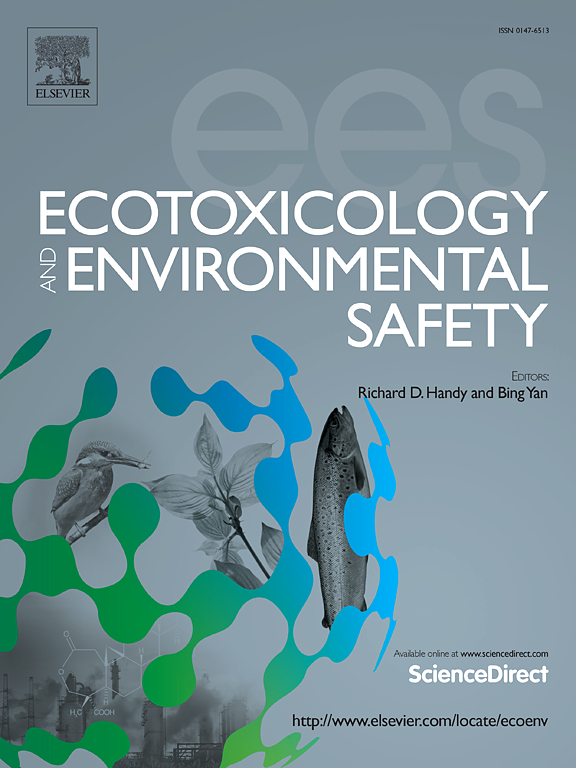Polystyrene nanoplastics aggravate house dust mite induced allergic airway inflammation through EGFR/ERK-dependent lung epithelial barrier dysfunction
IF 6.1
2区 环境科学与生态学
Q1 ENVIRONMENTAL SCIENCES
引用次数: 0
Abstract
Concerns that airborne micro- and nanoplastics (MNPs) may impair human respiratory health are rising. However, the specific effects of MNPs on allergic asthma remain insufficiently explored. This study developed an allergic asthma model using house dust mite (HDM), and mice were exposed to 50 μg polystyrene nanoparticles (PS-NPs) at three-days interval. Additionally, the effects and potential mechanisms of PS-NPs exposure (25, 50 and 100 μg/mL) on lung epithelial barrier dysfunction were explored using mouse lung epithelial type II (MLE-12) and A549 cells. The pathological changes of airway tissue and the increase of inflammatory response confirmed that exposure to PS-NPs significantly aggravated allergic asthma in mice. Importantly, in the presence of HDM sensitization, the accumulation of PS-NPs in the alveolar region was increased, leading to lung epithelial barrier dysfunction and more Th2-mediated eosinophilic inflammation, characterized by elevated IL-4, IL-13, immunoglobulin E (Ig E) and eosinophils. The activation of the epidermal growth factor receptor (EGFR) pathway and its downstream extracellular regulating kinase (ERK) was investigated using transcriptomic sequencing to elucidate the effects of PS-NPs exposure on lung epithelial barrier dysfunction. Furthermore, an EGFR-specific inhibitor AG1478 was employed to confirm the role of the EGFR/ERK pathway in lung epithelial barrier dysfunction and asthma exacerbation in vitro and in vivo experiments. In conclusion, the molecular mechanism by which PS-NPs aggravates asthma in mice was elucidated, which helps to improve the understanding of the health effects of PS-NPs and lays a theoretical foundation for addressing the health risks posed by PS-NPs.
聚苯乙烯纳米塑料通过EGFR/ erk依赖性肺上皮屏障功能障碍加重尘螨致变应性气道炎症
人们越来越关注空气中的微和纳米塑料(MNPs)可能损害人类呼吸系统健康。然而,MNPs对过敏性哮喘的具体影响仍未得到充分探讨。本研究以屋尘螨(HDM)建立过敏性哮喘模型,小鼠每隔3天暴露于50个 μg聚苯乙烯纳米颗粒(PS-NPs)。此外,我们还利用小鼠肺上皮II型(MLE-12)和A549细胞,探讨了暴露于PS-NPs(25、50和100 μg/mL)对肺上皮屏障功能障碍的影响及其潜在机制。气道组织的病理改变和炎症反应的增加证实了PS-NPs暴露可显著加重小鼠变应性哮喘。重要的是,在HDM致敏的情况下,肺泡区PS-NPs的积累增加,导致肺上皮屏障功能障碍和更多th2介导的嗜酸性粒细胞炎症,其特征是IL-4、IL-13、免疫球蛋白E (Ig E)和嗜酸性粒细胞升高。利用转录组测序研究了表皮生长因子受体(EGFR)通路及其下游细胞外调节激酶(ERK)的激活,以阐明PS-NPs暴露对肺上皮屏障功能障碍的影响。此外,我们利用EGFR特异性抑制剂AG1478在体外和体内实验中证实了EGFR/ERK通路在肺上皮屏障功能障碍和哮喘加重中的作用。综上所述,阐明了PS-NPs加重小鼠哮喘的分子机制,有助于提高对PS-NPs健康作用的认识,为解决PS-NPs带来的健康风险奠定理论基础。
本文章由计算机程序翻译,如有差异,请以英文原文为准。
求助全文
约1分钟内获得全文
求助全文
来源期刊
CiteScore
12.10
自引率
5.90%
发文量
1234
审稿时长
88 days
期刊介绍:
Ecotoxicology and Environmental Safety is a multi-disciplinary journal that focuses on understanding the exposure and effects of environmental contamination on organisms including human health. The scope of the journal covers three main themes. The topics within these themes, indicated below, include (but are not limited to) the following: Ecotoxicology、Environmental Chemistry、Environmental Safety etc.

 求助内容:
求助内容: 应助结果提醒方式:
应助结果提醒方式:


